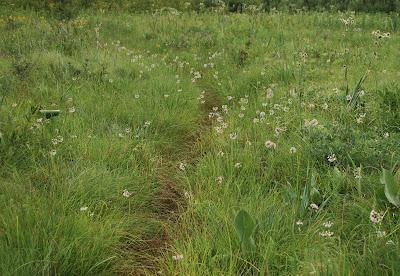One of the first days of August this year I visited The University of Wisconsin Arboretum in Madison.There is so much to see here and very excited, I stopped already directly at the entrance to the park at a colorful prairie planting with Yellow Coneflower, Ratibida pinnata, Sweet Coneflower, Rudbeckia subtomentosa, Culver's Root, Veronicastrum virginicum and Pale Indian Plantain, Arnoglossum atriplicifolium, among other prairie species.
Steve Glass is telling me about the Curtis Prairie
At the Visitor Center I met Steve B. Glass who showed me around and was my excellent guide the whole day. Steve is as restoration ecologist responsible for the restoration planning and the fire management at the University of Wisconsin-Madison Arboretum where he has been active in all phases of prairie restoration since the late 80s.
Steve showed me first the Native Plant Garden and then we walked out on the Curtis Prairie and studied the dynamics of prairie vegetation. My guide turned out to be a skilled prairie ecologist and since he was both pleasant and accommodating, we had a very fruitful day in the great outdoors.
Afterwards, Steve gave me even a bag full of interesting material and a book on plants at Madison Arboretum, which I had great pleasure from.
A colorful prairie planting already at the entrance to the Arboretum.
Yellow Coneflower and Pale Indian Plantain at the entrance
Eupatorium purpureum in the dry shade beneath a Bur Oak
Purple Coneflowers, Echinacea purpurea, at the Curtis Prairie
Curtis Prairie is the oldest restored prairie in North America and occupies about 60 acres of land. It is a deep-soil tallgrass prairie with a huge diversity of prairie plants. In July and August the Liatris, Monarda and Echinacea provide for the greatest color display and in early fall it is the grasses and the sumacs who excel in the most brilliant fall colors. The Smooth Sumac, Rhus glabra, grows scattered almost everywhere on the Curtis Prairie and spreads by underground runners. In autumn the leaves turn deep scarlet red with less orange tints compared to Rhus typhina.
Ironweed and Yellow Coneflower at the edge of the Curtis Prairie
The Curtis Prarie with Liatris and Eryngiym yuccifolium
Along the path to Greene Prairie we passed through a small woodland with dry, sandy soil. Here we found many drought tolerant species as Plantain-leaved Pussytoes, Antennaria plantaginifolia, and the Silver Sage, Artemisia ludoviciana, growing among the patches of Smooth Sumac.
Big leaves of Prairie Dock, Silphium terebinthinaceum at Greene Prairie
Steve discoverd a hybrid between Compass Plant, Silphium laciniatum and Prairie Dock, Silphium terebinthinaceum with intermediate leaves growing at Greene Prairie
Nodding Onion, Allium cernuum, along the track























